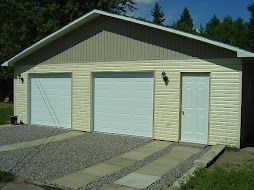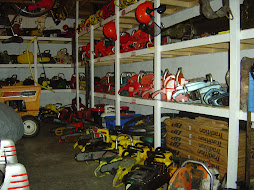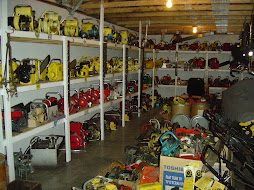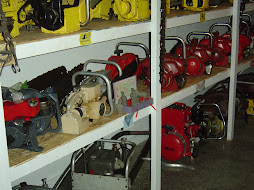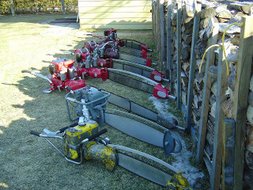


The new McCulloch Motors Inc. factory in Los Angeles.

McCulloch Motors Inc. Vice-Presidents and President: (L to R) Gerald Robechaud (Tools and Methods), Fred Breer (Sales), Sherwood Egbert (Production), Robert Paxton McCulloch, Secretary-Treasurer Joseph Hegener, John Ryde (Engineering) outside the new factory.
In the mid 1930's Robert Paxton McCulloch started McCulloch Engineering Company and began manufacturing superchargers as the first large American commercial supercharger manufacturer. They began developing superchargers for use on American passenger cars and hydroplane boats. This was the start of the supercharger industry in America as we know it today.
At the time of his death in 1925, John Irving Beggs was reported to be the wealthiest man in Wisconsin, with an estimated net worth of over $20M. He passed this incredible fortune to his grandchildren: John Irvin Beggs McCulloch(1908-1983), Robert Paxton McCulloch(1911-1977), and Mary Sue McCulloch(1913-1996) each going on to have incredible lives:
Grandson Robert was responsible for McCulloch Chainsaws, the Paxton Supercharger, founding Lake Havasu City, Arizona and moving the London Bridge to Arizona. He married Barbra Ann Briggs, whose father was Stephen Foster Briggs of Briggs and Stratton.
The success of McCulloch Motors, and the restless nature of Bob McCulloch, resulted in him selling McCulloch Motors to Borg Warner in 1943 for $1 million , which was subsequently invested in Pan American Airways stock. Six months later some of the stock was sold off and Bob McCulloch set up McCulloch Aviation Incorporated to manufacture 6,000 drone plane engines for the Army Air Force, based upon earlier lightweight two-cycle engines designed by McCulloch. As a result of this contract McCulloch felt that his future lay with featherweight two-cycle engines for Industrial use, and given that it was time for a change, and his current manufacturing facilities were not suitable, McCulloch uprooted McCulloch Aviation and moved it to California.
The move was made in 1946, and Los Angeles was picked due to low manufacturing costs and the availability of skilled mechanics. A fifteen acre piece of land was purchased opposite the airport and some old barracks set up to serve as offices and plant buildings. As well as Bob McCulloch and his family, a further 33 families of McCulloch Aviation employees made the move to Los Angeles, and as a part of the relocation Bob McCulloch bought 13 houses and 16 apartments to house these employees. Initially during 1946, whilst the 80,000 square foot factory was being built, old barracks buildings were used to house the offices and plant. Many of these had leaky roofs and probably did not create a very good impression when Henry Kaiser arrived with his retinue to enquire about a two cycle automobile motor, however they did serve the purpose and within 60 days of setting up the first engines (lawn mower and chain saw) were being produced out of these buildings, along with other staple items such as die-cast gas heaters.
The factory was completed in 1946 , costing around $1 million, and McCulloch Aviation became McCulloch Motors Corporation, and after evaluation of the product line Bob McCulloch dropped the heaters and development work for the Kaiser-Frazer two-cycle opposed piston engine, and decided to concentrate on the lawn mower and chainsaw engine product lines. These were built by McCulloch Motors Corp. and were supplied to Sears, Roebuck and Reed-Prentice respectively, and after extensive research by McCullochs engineers (and Vice-presidents) John Ryde and Gerald Robechaud, McCulloch found that he would could produce a better and lighter chainsaw by himself. As a result of this development McCulloch produced his first chainsaw the 5-49, which was 5Hp and weighed 49 pounds, was two-thirds the weight of it’s nearest rival, and cost $50 less, and sold in such volumes that McCulloch Motors 1947 sales of $4 million increased to $40 million by 1951, and a $2.5 million plant expansion was made in 1950.
MCCULLOCH 3-25:
INTRODUCED: 1950
DISCONTINUED: 1953
DISPLACEMENT: 4.71 cu. in. (77 cc)
BORE: 2.00 in. (50.8 mm)
STROKE: 1.50 in. (38 mm)
CYLINDER TYPE: Aluminum with cast iron sleeve
INTAKE METHOD: Rotary valve
MANUFACTURER ADVERTISED H.P.: 3 @ 4500 rpm.



